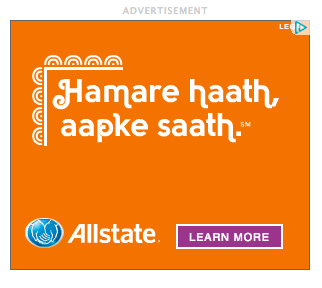Our hands, your mystification
« previous post | next post »
 This morning, a site that I often visit displayed in the upper right of the front page a small Allstate Insurance ad featuring the slogan "Hamare haath, aapke saath." This caught my linguistic attention, and since there was a vivid purple button reading LEARN MORE , I dutifully clicked on it.
This morning, a site that I often visit displayed in the upper right of the front page a small Allstate Insurance ad featuring the slogan "Hamare haath, aapke saath." This caught my linguistic attention, and since there was a vivid purple button reading LEARN MORE , I dutifully clicked on it.
But the result was just a larger Allstate page displaying the same slogan:
A bit of web search turned up this charming video advertisement on YouTube:
https://www.youtube.com/watch?v=krsYZURabvA
and also informed me that Allstate registered "HAMARE HAATH, AAPKE SAATH" as a trademark (filed 2014-10-28, registered 2015-03-24), for the area of "Insurance services, namely, underwriting, issuance and administration of property and casualty insurance", and that "The English translation of "HAMARE HAATH, AAPKE SAATH" in the mark is "OUR HANDS, WITH YOURS"."
The cultural context of the video suggests that the slogan's language is from South Asia, and indeed Google Translate identifies the language as Hindi (despite presentation in the latin alphabet rather than in devanagari):
I left the comma out the first time I tried it — putting the comma back in rendered Google Translate perplexed, in the familiar mode of powerful but brittle modern AI algorithms:
I presume the Urdu version of this slogan would be the same (in transliteration).
A reader will no doubt be able to give us a morphosyntactic analysis, and discuss the difference between "with you" and "with yours" in the translations.
But what I can't figure out is why I was selected for this ad — obviously something about my browsing history identified me as Indian (or Pakistani?), but it's not clear to me what it was.
In some cases the causative factor is clear if stupid. Often after I look something up for a LLOG post, I'm dogged for months by advertisements for an object or a service that I have no interest in purchasing. But the only recent triggering factor that I can think of in this case is following a Google News link to a South Asian newspaper.
I also wondered about Allstate's slogan transduction into other languages. It's easy to find the Spanish ("…en buenas manos") version, but what about Portuguese, or French, or German, or Russian, or Chinese? A marketing-newsletter article (Patricia Odell, "3 Multicultural Marketing Lessons from Allstate", 11/9/2015) suggests that Allstate markets insurance only in the U.S., and that Hindi might be a special case:
The challenge here was how to introduce Allstate to the Asian/Indian marketplace. This group is the fastest growing ethnic population in the U.S., has higher income compared to other segments and spends more than the general market. They are insurance savvy and like the personal touch of an agent. […]
“We needed to make the brand relevant by showing them we know how they truly live, that they are bi-cultural, succeeding in U.S., but holding on to tradition. That they are living a better life in the U.S. and that’s a direct result of their own effort and they understand value of all they have to lose,” she said.
The messaging that emerged was that “we understand what you have achieved because of your hard work and we can protect what you have,” she said. The creative, print and video, picked up design elements from Indian textiles and cultural nuances from the traditional spices the culture uses.
“We demonstrated that Allstate agents respect tradition and will be good partners,” she said. “We increased brand consideration and are exceeding online metrics that we put in place.”
But this 2003 Chicago Tribune article suggests that Allstate did something similar previously in Chinese:
[W]hen the insurance giant decided to target Chinese-Americans in a new advertising campaign rolling out this week in New York, it had to go to great lengths to redefine its age-old tagline, "You're in good hands with Allstate."
Instead, the campaign, which will air in Cantonese and Mandarin, translates the slogan as this: "Turn to our hands to be worry-free."
It's not clear whether they also presented the slogan in textual form, and if so, whether it was in Chinese characters or in pinyin or (for Cantonese) in some other transliteration.



Adam Carson said,
March 12, 2016 @ 9:12 am
The AdChoices icon in the top right of the ad means it was targeted to you, probably triggered by a visit to that newspaper site (or one like it) as you suspect. You have some control over which ads you see from Google's network (including the stubborn retargeting ones) here:
http://www.google.com/settings/ads
Brett said,
March 12, 2016 @ 9:26 am
The most remarkable thing to me was that I could immediately infer that the language was Hindi, because the font they used was stylistic suggestive of devanagari.
(By the way, is there a word for the alphabet used in English and many other European languages? "Latin" doesn't cut it, since our alphabet has distinguishes U and V, and I and J, and has the digraph letter W.)
Johanne D said,
March 12, 2016 @ 9:32 am
"Pour Allstate, le slogan «vous êtes en bonnes mainsMD» signifie, entre autres, être à la disposition de ses clients dès qu’ils en ont besoin." (allstate.ca)
Victor Mair said,
March 12, 2016 @ 9:38 am
hamaare हमारे
haath हाथ
aap ke आप के
saath साथ
I think it is "our hand your with", but Hindi / Urdu speakers can explain it more fully. I'll alert some friends to take a look.
Robert Coren said,
March 12, 2016 @ 10:31 am
@Brett: I'm prepared to be corrected, but it's my impression that, despite the fact that it doesn't exactly match the alphabet as used in ancient Rome, the standard term for our alphabet is, in fact, "Latin".
Stephen Politzer-Ahles said,
March 12, 2016 @ 10:47 am
Also not a Hindi speaker, but from the very tiny bit that I know, I remember that hamaare and aapke are possessives. So the "with yours translation is probably better than Google Translate's "with you".
michael farris said,
March 12, 2016 @ 10:56 am
My knowledge of hindi was never very good (and very ancient) but from what I remember
hamaare हमारे = our (or 'my')
haath हाथ = hand(s)
aap ke आप के = aap (you) ke (genitive/possessive marker) = your(s)
saath साथ = with (post position)
"Our hands with yours' is probably the more idiomatic translation since IIRC Hindi usually doesn't distinguish your and yours.
Theoretically some possessives agree in gender and number with the items possessed but I think those differences are levelled in colloquial usage a lot of the time in favor of an all purpose -e ending.
michael farris said,
March 12, 2016 @ 11:10 am
Just remembered, IIRC some postposition like structures are preceded by the genitive so aap ke saath might be "with you" as well as 'with yours'
Rod Johnson said,
March 12, 2016 @ 11:40 am
Every time I see a story like this I'm momentarily baffled. Ads? People still see ads? Why?
Leo said,
March 12, 2016 @ 12:28 pm
@michael farris – yes, it just means "with you." Our hands, with you. aap ke saath = with you, aap ke liye = for you, aap ke paas = by/with you.
Jerry Friedman said,
March 12, 2016 @ 1:09 pm
Rod Johnson: I can think of two possible reasons: because some people find ads interesting, and because some people want the sites they visit to continue getting income and thus continue existing.
Victor Mair said,
March 12, 2016 @ 1:43 pm
From Pushkar Sohoni:
Hamaare haath, aapke saath can potentially have two meanings.
1. Aapke can be broken down as aap (you plural or respectful) ke (of) saath (together; along with), therefore meaning 'with (those) of you' referring to hamaare haath (our hands); the sentence thus means 'Our hands, with those of you', i.e., 'Our hands with yours.'
2. The sentence can also be read as aap (you plural or respectful) and ke saath (to mean 'along with' qualifying 'hamaare haath'); the meaning is thus 'Our hands with you.'
And the extrapolated non-literal meaning is 'We are (always) with you.'
Gene Buckley said,
March 12, 2016 @ 4:33 pm
@Brett: Some writers reserve "Latin alphabet" for the form of the alphabet used specifically for the Latin language (lacking J, U, W in the Classical spellings), and "Roman alphabet" more broadly for its various adaptations for other languages (such as English). Thus, "Croatian is written in the Roman alphabet, and Serbian in Cyrillic." Others use the terms more loosely and interchangeably; but when a distinction is made, it's normally in this direction as far as I can recall.
[(myl) FWIW, Unicode inherits from earlier character-encoding systems the decision to call a whole set of scripts derived from the Romans "Latin":
That list includes hundreds of characters that the Romans never dreamt of, but it certainly includes the simple ASCII code-points used in the Allstate ad.
I used the word "alphabet" rather than "script" because the process of transliteration implicitly includes a system for translating phonology into alphabetic sequences, not just a simple mapping of character sequences into character sequences. But that's a complex space of distinctions without a standard terminology, as far as I know.]
michael farris said,
March 13, 2016 @ 1:48 am
@Gene Buckley: "Some writers reserve "Latin alphabet" for the form of the alphabet used specifically for the Latin language…"
The terminology I prefer (mostly) is "script" a general set of graphic alphabetic symbols and "alphabet" the subset of graphic symbols (and conventions for combining them) used to write a particular language.
For example the modern Turkish alphabet is based on the Latin script, it replaced the Arabic-script based Ottoman alphabet.
It doesn't always work when talking about non-alphabetic systems…
AG said,
March 13, 2016 @ 9:51 am
I seem to recall that the word for elephant in Hindi is related to that word for hand (something about the hand-like trunk giving its name to the whole animal), and thus the character name Hathi the Elephant in The Jungle Book.
Lazar said,
March 13, 2016 @ 11:04 am
I've always been a bit perplexed by those fictional animal names that are just the name of the animal's species in another language.
Andrew (not the same one) said,
March 13, 2016 @ 2:57 pm
I think they derive from fables, where the animal is symbolic of the species; his name is 'Elephant' because we are meant to imagine him as the only elephant. Consider Br'er Rabbit, Br'er Fox, etc; or the Just So Stories, with titles like 'How the Leopard' [the only one] 'Got his Spots'.
Of course, The Jungle Book is a bit more realistic than that, and we are meant to suppose that there are several elephants, but it keeps up the tradition. If you want to get it to make sense, I guess you could imagine that Hathi is called 'The Elephant' because he is the chief of the elephants, in the tradition of clan chiefs like The Chisholm, etc.
Darryl S said,
March 16, 2016 @ 7:06 am
Re: "I can't figure out is why I was selected for this ad":
I irregularly get ads served to me in French; sometimes, clearly the French version of an ad that I recall seeing earlier or elsewhere in English. I've never figured the reason out; yes, I'm browsing from Canada, and yes, it's a bilingual country, but (to my own self-disappointment) I can barely read simple French sentences, and certainly don't browse French-language websites.
Bloix said,
March 16, 2016 @ 1:38 pm
That is some good advertising.